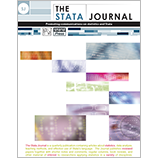A combined test for a generalized treatment effect in clinical trials with a time-to-event outcome
Patrick Royston
MRC Clinical Trials Unit
University College London
London, UK
[email protected]
|
Abstract. Most randomized controlled trials with a time-to-event outcome are designed and
analyzed assuming proportional hazards of the treatment effect. The sample-size
calculation is based on a log-rank test or the equivalent Cox test.
Nonproportional hazards are seen increasingly in trials and are recognized as a
potential threat to the power of the log-rank test. To address the issue,
Royston and Parmar (2016, BMC Medical Research Methodology 16: 16)
devised a new "combined test" of the global null hypothesis of identical
survival curves in each trial arm. The test, which combines the conventional
Cox test with a new formulation, is based on the maximal standardized
difference in restricted mean survival time (RMST) between the arms. The test
statistic is based on evaluations of RMST over several preselected time points.
The combined test involves the minimum p-value across the Cox and
RMST-based tests, appropriately standardized to have the correct null
distribution. In this article, I outline the combined test and introduce a
command, stctest, that implements the combined test. I point the way to
additional tools currently under development for power and sample-size
calculation for the combined test.
View all articles by this author:
Patrick Royston
View all articles with these keywords:
stctest, randomized controlled trial, time-to-event outcome, restricted mean survival time, treatment effect, hypothesis testing, flexible parametric model, jackknife
Download citation: BibTeX RIS
Download citation and abstract: BibTeX RIS
|
